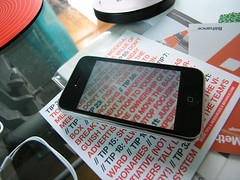Well, I'll be the first to admit that some areas of digital signage are pretty sickly these days, but really... dead? Of course, I'd be willing to be swayed by a sound argument, but there I found the blogger's argument to be somewhat lacking:
My point is, there is an emerging market that is interested in emerging technology. The fact is, (as I heard it said recently), digital signage is not an emerging technology.Why mobile won't kill digital signage
...[With mobile marketing] all that is necessary is to explore and invest in methods to deliver a message or a useful tool with pertinent content to the device. There is no commitment to hardware screens and player solutions with a shelf life, that has been put off onto the end viewer who now owns the system, and carries it with them wherever they go. That alone is a deal breaker for traditional methods of narrowcasting that have been, in recent years, re-packaged as "Digital Signage".
To be frank, a scenario where the iPhone and other handheld devices eliminate the need for digital signage seems very unlikely, and I'll give you three reasons why:
- Numbers: Apple has sold about 10 million iPhones since the device's debut in 2007. Assuming that all of them are still in the US (which is mostly true), that means about 3% of the population has one. Since the device and its required service are expensive, those 10 million people will naturally clump together in the high end of the socioeconomic spectrum. Now, how many of those 10 million have done something to make themselves available to mobile marketers in the first place? (I'd be surprised if even 5% of users have done so). In contrast, Walmart TV had over 130 million viewers each month, and that was way back in 2005. Today, something like 80% of Americans shop at Walmart, giving it a reach that mobile -- even spanning all "smart" devices -- won't be able to match for a decade or more. And that's just one digital signage network.
- Context: Enter a store and you are, by definition, entering a place of commercial enterprise. You're probably there to buy stuff. But even if you're just browsing, there's an understanding that the retailer wants to sell you things, and you have some interest in seeing what's available. There is a shared expectation that the store will contain marketing content, and you're at least mildly interested in consuming it. Because of this, the retail store is the most natural environment for advertising that you'll ever find. And provided that retailers steer clear of using digital signage in ways that compromise viewer privacy, this mutually-beneficial relationship should remain in effect for many years to come. Don't like the content? You're free to leave, and as soon as you do, the ads are gone too. I wish all ads were so contextually relevant. TV commercials would only show up when I was in the mood to make a purchase, and newspapers would be full of -- gasp -- news.
- Control: Digital signs give the marketer complete control over when, where and how a message is delivered. Mobile devices on the other hand, remain in the control of the consumer. While that's as it should be, there might be a hundred different, non-commercial reasons why I whip out my cellphone. Maybe I want to check sports scores. Perhaps I'm looking up an address. I could even want to call someone. Unlike an in-store digital sign that has a fixed purpose and is operated by the store as a retail fixture, my mobile phone is mine. Unless I request the content specifically by visiting your website or sending a text message, you have no way of reaching me through my phone unless I'm part of the tiny minority that has enabled you to do so whenever you wish. (Yes, I realize that there are whole demographics that might fit into that tiny minority, and that mobile is a great medium for reaching those people. I'm talking big-picture here.)
People love their cell phones and are becoming more dependent on them every day. In time, more cell phone users will be willing to accept mobile marketing. It'll happen a little bit this year, a little bit next year, and in seven or eight years, the available audience will be pretty big. In the meantime, mobile marketing will focus on those niche audiences that have a natural propensity for buying the latest gadgets and giving out all sorts of personal information in exchange for a chance to win a pair of Kelly Clarkson tickets. Billboards, posters and digital signs will continue to use "easy" mobile marketing like SMS text messaging to engage viewers and measure audience interaction.
One thing is clear, though: as long as most people either don't want ads on their mobile phone (or are unable to receive them), that medium simply can't displace well-run digital signage networks. Likewise, as long as there are brands who need a guarantee that their messages will appear at a certain place and time, there will be a need for a media channel that the venue can control. Digital signage and mobile marketing are natural allies when considered in the context of multi-channel marketing campaigns, but there's simply no way that one can do the job of the other.
What do you think? Is digital signage on the verge of being replaced by another medium? Or, will emerging media actually make digital signs more important and effective?


 Subscribe to the Digital Signage Insider RSS feed
Subscribe to the Digital Signage Insider RSS feed
Comments
RSS feed for comments to this post